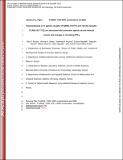Polymorphisms in Fc gamma receptor (FcγRIIIA-176 F/V) and Toll-like receptor (TLR9 [-1237 T/C]) are associated with protection against severe malarial anemia an...
| dc.contributor.author | Munde, Elly O | |
| dc.contributor.author | Okeyo, Winnie A | |
| dc.contributor.author | Anyona, Samwel B | |
| dc.contributor.author | Raballah, Evans | |
| dc.contributor.author | Konah, Stephen | |
| dc.contributor.author | Okumu, Wilson | |
| dc.contributor.author | Ogonda, Lilian | |
| dc.contributor.author | Vulule, John | |
| dc.contributor.author | Ouma, Collins | |
| dc.date.accessioned | 2018-01-23T11:26:45Z | |
| dc.date.available | 2018-01-23T11:26:45Z | |
| dc.date.issued | 2012-10-08 | |
| dc.identifier.uri | https://repository.maseno.ac.ke/handle/123456789/196 | |
| dc.description.abstract | Understanding the immunogenetic basis of naturally acquired immunity to Plasmodium falciparum infection would aid in designing a rationally-based malaria vaccine. Variants within the Fc gamma receptors (FcγRs) mediate immunity through engagement of immunoglobulin (Ig) G and other immune mediators such as interferon gamma (IFN-γ), resulting in erythro-phagocytosis and production of inflammatory cytokines in severe malarial anemia (SMA). The toll-like receptors (TLRs) trigger transcription of pro- inflammatory cytokines and induce adaptive immune responses. Therefore, these receptors may condition malaria disease pathogenesis through alteration in adaptive and innate immune responses. To further delineate the impacts of FcγRIIIA and TLR9 in SMA pathogenesis, the association between FcγRIIIA-176 F/V, TLR9 (-1237 T/C) variants, SMA … | en_US |
| dc.publisher | American Society for Microbiology | en_US |
| dc.title | Polymorphisms in Fc gamma receptor (FcγRIIIA-176 F/V) and Toll-like receptor (TLR9 [-1237 T/C]) are associated with protection against severe malarial anemia an... | en_US |
| dc.type | Article | en_US |

